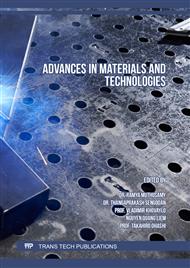[1]
T. Wohlers, R.I. Campbell, O. Diegel, N. Mostow, J. Kowen: Wohlers Report 2021: 3D Printing and Additive Manufacturing State of the Industry, Wohlers Associates, Fort Collins, Colo., (2021).
Google Scholar
[2]
E. Witt, C. Anton: Additive Fertigung: Entwicklungen, Möglichkeiten und Herausforderungen: Stellungnahme, Halle (Saale), (2020).
Google Scholar
[3]
A. Weckenmann, G. Akkasoglu, T. Werner: Quality management—history and trends. In: The TQM Journal; ISSN: 1754-2731. Vol. 27 No. 3, p.281–293. https://doi.org/10.1108/TQM-11-2013-0125.
DOI: 10.1108/tqm-11-2013-0125
Google Scholar
[4]
R.H. Hayes, S.C. Wheelwright: Restoring our competitive edge: Competing through manufacturing, Wiley, New York, N.Y., (1984).
Google Scholar
[5]
H.J. Fahrenwaldt, V. Schuler: Praxiswissen Schweißtechnik: Werkstoffe, Prozesse, Fertigung, 3rd ed., Vieweg + Teubner, Wiesbaden, (2009).
DOI: 10.1007/978-3-658-03141-1
Google Scholar
[6]
C. Pohle: Schweißen von Werkstoffkombinationen: Metallkundliche und fertigungstechnische Grundlagen sowie Ausführungsbeispiele, Verl. für Schweißen und Verwandte Verfahren DVS-Verl., Düsseldorf, (1999).
DOI: 10.1002/stab.200002010
Google Scholar
[7]
S. Katayama (Ed.): Handbook of laser welding technologies, Woodhead Publ, Oxford, (2013).
Google Scholar
[8]
Yaqoob Mohsin Baqer, S. Ramesh, F. Yusof, S. Manladan: Challenges and advances in laser welding of dissimilar light alloys: Al/Mg, Al/Ti, and Mg/Ti alloys, (2018).
DOI: 10.1007/s00170-017-1565-6
Google Scholar
[9]
J.-F. Nie: Physical Metallurgy of Light Alloys, in: D.E. Laughlin, K. Hono (Eds.), Physical Metallurgy, 5th ed., Elsevier Science, Burlington, 2014, p.2009–2156.
DOI: 10.1016/b978-0-444-53770-6.00020-4
Google Scholar
[10]
Y. Mae: What the Darken–Gurry Plot Means About the Solubility of Elements in Metals, Metall Mater Trans A 47 (2016) 6498–6506. https://doi.org/10.1007/s11661-016-3730-1.
DOI: 10.1007/s11661-016-3730-1
Google Scholar
[11]
PubChem, Periodic Table of Elements, 2021, https://pubchem.ncbi.nlm.nih.gov/periodic-table/, accessed 23 January (2022).
Google Scholar
[12]
K.A. Gschneidner, M. Verkade: Electronic and crystal structures, size (ECS2) model for predicting binary solid solutions, Progress in Materials Science 49 (2004) 411–428. https://doi.org/10.1016/S0079-6425(03)00026-4.
DOI: 10.1016/s0079-6425(03)00026-4
Google Scholar
[13]
MatWeb: Material Property Data of Aluminum, Al, 2022, http://www.matweb.com/search/ datasheet.aspx?bassnum=AMEAL00&ckck=1, accessed 23 January (2022).
Google Scholar
[14]
MatWeb: Material Property Data of Titanium, Ti, 2022, http://www.matweb.com/search/ DataSheet.aspx?MatGUID=66a15d609a3f4c829cb6ad08f0dafc01, accessed 23 January (2022).
Google Scholar
[15]
J.-P. Kruth, P. Mercelis, J. van Vaerenbergh, L. Froyen, M. Rombouts: Binding mechanisms in selective laser sintering and selective laser melting, Rapid Prototyping Journal 11 (2005) 26–36. https://doi.org/10.1108/13552540510573365.
DOI: 10.1108/13552540510573365
Google Scholar
[16]
V. Seyda: Werkstoff- und Prozessverhalten von Metallpulvern in der laseradditiven Fertigung. Dissertation.
DOI: 10.1007/978-3-662-58233-6_7
Google Scholar
[17]
Umberto Scipioni Bertoli, Alexandra Wolfer, M. Matthews, J. Delplanque, J. Schoenung: On the limitations of Volumetric Energy Density as a design parameter for Selective Laser Melting, (2017).
DOI: 10.1016/j.matdes.2016.10.037
Google Scholar
[18]
W.E. King, H.D. Barth, V.M. Castillo, G.F. Gallegos, J.W. Gibbs, D.E. Hahn, C. Kamath, A.M. Rubenchik: Observation of keyhole-mode laser melting in laser powder-bed fusion additive manufacturing, Journal of Materials Processing Technology 214 (2014) 2915–2925. https://doi.org/10.1016/j.jmatprotec.2014.06.005.
DOI: 10.1016/j.jmatprotec.2014.06.005
Google Scholar
[19]
N.K. Tolochko, Y.V. Khlopkov, S.E. Mozzharov, M.B. Ignatiev, T. Laoui, V.I. Titov: Absorptance of powder materials suitable for laser sintering, Rapid Prototyping Journal 6 (2000) 155–161. https://doi.org/10.1108/13552540010337029.
DOI: 10.1108/13552540010337029
Google Scholar
[20]
A. Schaub, B. Ahuja, M. Karg, M. Schmidt, M. Merklein: Fabrication and Characterization of Laser Beam Melted Ti-6Al-4V Geometries on Sheet Metal, Proceedings / DDMC 2014, Fraunhofer Direct Digital Manufacturing Conference, March 12 - 13, 2014, Berlin (2014).
DOI: 10.1016/j.phpro.2014.08.102
Google Scholar
[21]
H. Ali, H. Ghadbeigi, K. Mumtaz: Effect of scanning strategies on residual stress and mechanical properties of Selective Laser Melted Ti6Al4V, Materials Science and Engineering: A 712 (2018) 175–187. https://doi.org/10.1016/j.msea.2017.11.103.
DOI: 10.1016/j.msea.2017.11.103
Google Scholar
[22]
K. Osakada, M. Shiomi: Flexible manufacturing of metallic products by selective laser melting of powder, International Journal of Machine Tools and Manufacture 46 (2006) 1188–1193. https://doi.org/10.1016/j.ijmachtools.2006.01.024.
DOI: 10.1016/j.ijmachtools.2006.01.024
Google Scholar
[23]
Y. Zhang, J. Zhou, D. Sun, X. Gu: Nd:YAG laser welding of dissimilar metals of titanium alloy to stainless steel without filler metal based on a hybrid connection mechanism, Journal of Materials Research and Technology 9 (2020) 1662–1672. https://doi.org/10.1016/j.jmrt.2019. 12.001.
DOI: 10.1016/j.jmrt.2019.12.001
Google Scholar
[24]
E. Siebel, M. Gaier: Untersuchungen über den Einfluss der Oberflächenbeschaffenheit auf die Dauerschwingfestigkeit metallischer Bauteile, VDI-Zeitschrift (1956) 1715–1723.
Google Scholar
[25]
M. Peters (Ed.): Titan und Titanlegierungen, 3rd ed., Wiley-VCH, Weinheim, (2002).
Google Scholar



